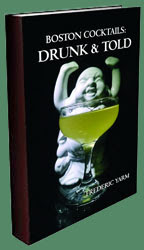For an afternoon talk at Thirst Boston two Saturdays ago, I joined in on Brother Cleve's Walking Tour of Boston. There was certainly a lot of history packed into this hike, and a lot of insight of what it was like turning 18 -- the legal drinking age in Cleve's youth -- way back when. Cleve did reveal that his first drink in a bar came back at age 16, but places were not as strict as they once were. The tour included places of old (and some still existent) jazz clubs, gay bars, dives, punk rock venues, mob hit sites, Tiki bars (note: multiple!), cruising venues, movie theaters, and more. Such a wealth of lore about a Boston that once was. And in some cases still is. Sometimes, you could see how the front of a Chinese restaurant used to be the grand marquee of a movie theater, and other times the location was razed to put a tower in like some of the seedier strip clubs on Lagrange Street. In the photo below, Cleve was giving the history of the street but the only two baudy places still in existence there were on the side that was not leveled. The Glass Slipper was on that now defunct side before being moved across the street, and we were all amused by the sign that read, "The Glass Slipper where every gentleman is a VIP..."

Earlier, we passed by the plaque that told the history of the Cocoanut Grove Club that burned down in one of the largest nightclub fires in 1942. Up the street was the brick barn-like front to the old Napoleon's where older men sang show tunes at the piano bar and where younger men searched for their sugar daddies; Judy Garland spent her last days there in 1969 drinking her way away. Up the street is the city's oldest gay bar, Jacque's, that opened in 1938 before it turned into more of a female impersonator club in the 1940s until present day. Places that were also razed included Herbie's Ramrod Room, a leather bar that moved to the Fenway area, and the Hillbilly Ranch, a rough Honky Tonk that luckily never reopened elsewhere in the city. The lost Tiki establishments included the South Seas on Harrison Street that lasted from the 1960s until the 1980s, Bob Lee's Islander that lasted during that same era and sported a psychedelic interior, and a Trader Vic's that was in the old Hilton Hotel that became the current Park Plaza.

1 1/2 oz Writer's Tears Irish Whiskey
3/4 oz Carpano Antica Sweet Vermouth (Cleve prefers Cinzano though)
3/4 oz Green Chartreuse
Stir with ice, strain into a cocktail coupe, and garnish with orange oil from a twist.
The final stop was at Explorateur in Boston that used to house a Masonic lodge at the edge of what was once the Combat Zone. There we partook of one of Cleve's favorite Irish whiskey drinks, the Tipperary, that honored the tour's sponsor, Writer's Tears Whiskey. The Tipperary originally appeared in Hugo Ensslin's 1916
Recipes for Mixed Drinks as an equal parts drink sans garnish that was the Irish whiskey take on the gin
Bijou from Harry Johnson's 1882
New and Improved Bartender's Manual. Here, Cleve dried out the drink by bringing the whiskey forward into a 2:1:1 ratio instead of the classic's 1:1:1, and he added an orange twist. No great surprises here with the Irish whiskey forming the backbone to the sweet vermouth's richness and the Green Chartreuse's herbal notes.


 The 2017 collection of 855 drink recipes, bartender tributes, and essays on hospitality from CocktailVirgin's Frederic Yarm. Available at
The 2017 collection of 855 drink recipes, bartender tributes, and essays on hospitality from CocktailVirgin's Frederic Yarm. Available at  The 2012 collection of 505 drink recipes, techniques, and Boston bar recommendations from Frederic Yarm. Available at
The 2012 collection of 505 drink recipes, techniques, and Boston bar recommendations from Frederic Yarm. Available at 




No comments:
Post a Comment